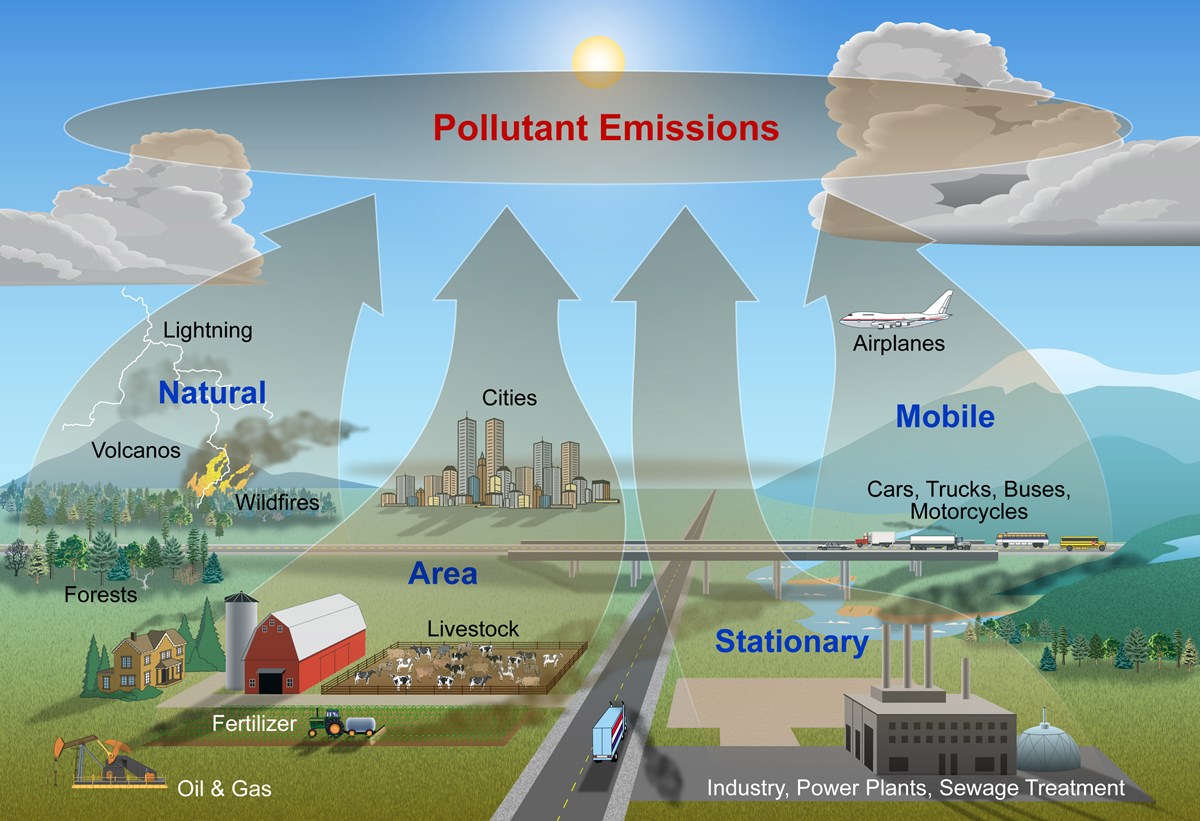Introduction
Air pollution is a significant global problem, and human beings have contributed significantly to this issue. Air Quality Indices (AQI) around the world are showing unhealthy levels of pollution and particulate matter owing to the burning of fossil fuels and unhealthy practices such as mining (ABC, 2020). Some cities have such severe air pollution problems that visibility becomes impacted. Some areas are nearly permanently affected, while air pollution in other areas can be from temporary issues such as bushfires (UNEP, 2020).
Source: National Geographic
Definitions
The World Health Organisation (WHO) defines air pollution as ‘the contamination of the indoor or outdoor environment by any chemical, physical or biological agent’ (WHO, 2025). It includes emissions from vehicles, factories, dust, pollen, mould, smoke, and volcanic eruptions. While some air pollution is natural, the introduction of unnatural pollutants is causing environmental and human health hazards.
Sources of air pollution
Sources of air pollution include the emissions from petrol and diesel vehicles, waste from oil refineries, runoff from agricultural fields, and the burning of coal in power stations, power plants, and chemical factories. All of which accumulate in the air and reduce oxygen content. Naturally occurring pollutants, including bushfires and volcanoes, temporarily alter the atmospheric content and are part of the natural cycle. Winter wood burning in cold countries or wood for cooking food and for hot water also contribute to air pollution (Thompson, 2019).

Source: US National Park Service
Fine particulate matter (PM2.5) is important in air quality determinations (small particles of soot, ash, and dust) as it has long-lasting effects. These fine particles travel down the throat and get trapped in the lungs (EPA, 2025) of both humans and animals. High levels of fine particles over a short time can also cause cardiovascular problems.
The impact of vehicular pollution
Air pollution from automobiles increased rapidly with urbanisation and the increase in the global population. As a result of the global population increase, the number of cars, trucks, and motorbikes increased significantly, again increasing the air pollution from vehicles. The major pollutants from cars include ozone (O3), particulate matter (PM2.5), nitrogen oxides (NOx), carbon dioxide (CO2), carbon monoxide (CO), and sulphur dioxide (SO2) (NSW Gov, 2025).
These compounds are known as Volatile Organic Compounds (VOCs), and their volatility contributes to climate change, acid rain, and vehicle damage when introduced into the atmosphere.
Incidents that took place owing to air pollution
Every country has incidents with air pollution. Even isolated places like Antarctica are starting to record high levels of pollutants. In 2010, the eruption of the Eyjafjallajökull volcano in Iceland caused the loss of GBP£130 million in revenue per day (across the global airline industry) owing to cancelled flights. This number does not take into account the environmental toll and the loss of natural services. In 1984, more than 3000 people died with thousands more hospitalised in India when a polymer factory leaked poisonous styrene gas (Broughton, 2005). The health ramifications are still being felt today.
Australian bushfires also significantly contribute to air pollution, with 19 million hectares burnt in the 2019 – 2020 bushfire season. Smoke from the currently burning Grampians fire has also reportedly reached Antarctica. Mount Isa City in North-West Queensland was also named as the most polluted city in the world one day in 2024 owing to a large bushfire burning nearby which, combined with emissions from nearby smoke stacks, blocked out the sun and covered houses in ash (ABC, 2025).
Source: The Dark History
Pollution from Household Cooking
Around 7 million people die each year from air pollution, especially in less developed countries, where breathing the smoke of cooking fires causes approximately 3.8 million deaths each year (WHO, 2024). Households with low incomes often possess inefficient stoves and use burning fuels such as dung, wood, dry leaves, and charcoal, which produce harmful, damaging pollutants, including particulate matter, methane, carbon monoxide, polyaromatic hydrocarbons, and volatile organic compounds. In addition, the usage of simple kerosene wick lamps produces significant emissions of fine particles and other pollutants. Switching to more efficient cooking methods, such as solar-powered ovens, will make significant reductions in emissions.
Health Problems Owing to Air Pollution
Living in an area with high exposure to air pollution can have profound effects on the body. The effects differ based on whether exposure is short or long-term, acute or chronic. As a result, short and long-term diseases affect people, pets, and animals. Short and long-term exposure to air pollutants can cause diseases such as lung cancer, asthma, dementia, inflammation, cardiovascular diseases, and chronic obstructive pulmonary disorders and can impact the central nervous system (WHO, 2025).
Source: EEA
Money lost owing to air pollution
Air pollution in 2020 had global effects, especially in the world’s busiest cities. Billions of dollars are spent per country on relieving the effects of air pollution. The table below highlights some of the world’s largest cities and the amount of money spent on the effects of air pollution in one year, 2020. This includes medical costs, monitoring, and clean up. This money would be saved if air pollution was not an issue.
| City & Country | Expenditure (USD) |
| Tokyo, Japan | $43 billion |
| Delhi, India | $8.1 billion |
| Shanghai, China | $19 billion |
| Mexico City, Mexico | $8 billion |
| Sao Paulo, Brazil | $7 billion |
| Los Angeles, California | $32 billion |
| Beijing, China | $16 billion |
Source: IQAir
How can we control air pollution?
There are several methods to control the emission of harmful gases into the atmosphere (QLD Gov, 2025). Most notably, replacing old petrol and diesel cars with electric cars and cars running on biodiesel fuel will greatly reduce emissions. Governments could provide green incentives to new car owners to improve uptake rates (DCCEEW, 2025).
Coal-based thermal power plants should be replaced by clean energy methods such as solar, wind, hydropower, and geothermal energy. As coal is a significant contributor to climate change and fossil fuel use, this must be done as a matter of priority. While individuals are paying for solar power out of their own pockets, governments need to step up and take control over the transition instead of hanging on to outdated and expensive, climate-wrecking coal stations. Households should also be provided with, or encouraged to uptake, more efficient cooking systems such as electric ovens over fires. This will improve their health and reduce cooking times. Planting trees will also aid in reducing carbon emissions.
Where such travel exists, public transport should be used in preference to personal vehicles (QLD Gov, 2025). Trains, trams, and buses should be the main modes of transport. One train will reduce the emissions of approximately 200 cars’ worth of emissions each year. For short distances able people should walk or cycle rather than use cars. This will also aid their fitness.
Moving forward
It is the collective responsibility of both government and individuals to work towards countering the major problem of air pollution. Educating students on topics related to pollution will make them more conscious about their actions and thereby help them make more environmentally conscious decisions (UNESCO, 2025). Governments should provide charging stations to cover the country and also give subsidies and tax benefits to the new electric vehicle owners. This will reduce carbon emissions and fossil fuel consumption. Death rates from air pollution are increasing and will continue to increase unless we take action to control it. Improving air quality is essential for better lives and healthy futures.
The Importance of Clean Air
Clean air is essential for good health. As fossil fuels are the primary cause of air pollution, we must immediately stop burning them. We must be more conscious of the emissions we produce and consciously ensure we do not emit more pollutants than we produce clean air. Cars should be built with better emission standards, and the environment should become a conscious part of every decision we make (Australian Government 2025).
Achieving the United Nations Sustainable Development Goals (SDGs) through Improved Air Quality
Clean air links to many of the United Nations Sustainable Development Goals (SDG) as it is a crucial step to sustainability. SDG13: Climate Action relates to the mitigation of climate change and the future viability of ecosystems. Improving air quality is a major step in mitigating climate change. SDG11: Sustainable Cities and Communities is concerned with creating cities that are resilient, sustainable, and safe. Air pollution is harmful, reducing the sustainability and safety of cities. Thus, reducing air pollution aligns with SDG11. SDG3: Good Health and Well-Being, concerned with the health of individuals of all ages, also improves when the health hazards associated with poor air quality are reduced.
These SDGs link to pollution and the sustainability of cities. A city cannot be sustainable, much less thrivable, with issues like air pollution. The areas affected by air pollution need to take climate action to improve air quality for the sake of both the environment and the residents of those areas.
A Thrivable Framework
THRIVE Project, a not-for-profit environmental group, dedicate its time to creating a world that goes beyond sustainability. To where the world is net positive and humans flourish alongside all other species. This is thrivability. A world that values nature as a precious commodity. The transition away from fossil fuels is a critical step to achieving thrivability. THRIVE uses 12 Foundational Focus Factors (FFFs) to improve world issues and ensure the planet works towards a thrivable future. Of the 12 FFFs, Strong Sustainability is most relevant to air pollution as it deals with climate issues and environmental health, creating a more sustainable world. Improving air quality improves sustainability; therefore strong sustainability and air quality have strong links.
Integral Thinking works with environmental thresholds, such as the maximum atmospheric pollutant levels before damage occurs. This includes both human and environmental health. Therefore, levels of air pollution and air quality indices use integral thinking in their design. Science Based-Targets are means by which we can measure progress towards targets. In this case, they are useful in measuring pollution levels and setting lower emission goals.
To find out more about THRIVE Project visit the website, read published articles, the newsletter, and blogs. Watch webinars and attend workshops. More content is also available on the YouTube channel. You can also volunteer with THRIVE to collaborate towards a flourishing future.























